Web Application Design for School Organisation Optimization
Â
- Application and Knowledge Design
At first, the ontology will be planned in accordance with the methodology of ontology building.
Description of the Ontology
The ontology domain is based upon the running of a school. The goal of the research is to provide users of the applications with the prospects to get information regarding the requirement that is required in the running of a school. The school will incorporate classes, departments, subjects, all staff etc.
Queries
In order to get all the required information, a number of queries have to be performed throughout the web. Coupled with the required information, it can be stated that the following queries need to be performed.
- What is taught Monday morning in room CWG/03 at 9am?
- How many girls are in year 10 take Science?
- How old is the head teacher?
- What teacher is head of the sports department?
- Who teachers Geography and also Sports?
- Please give all the names of teachers and their email addresses if known.
- How many of the admin team are under 40 years of age?
- Admin Staff members whose surname begin with “W”
- Retrieve all teachers and their qualifications
- Retrieve the name of all subjects taught by the teacher with ID 2341
- Why the Domain is Interesting to an Audience?
The shift of the paradigms in the field of education in the recent decades, as well as the spreading of education, proposes ways through which the education can be provided under one roof. Practitioners and researchers are making every attempt to find approximate methodologies for making education easily available to every human being. With the proposed ontology, the user can have a concept of the school and will be able to develop the school system in any part of the world with an ease of the information technology. The respective domain ontology will act as an instrument for the construction of the school system in an effective and efficient manner.
- Consider Salvaging Existing Ontologies
In order to make an application that fulfils the needed requirements, the following ontologies have been deployed.
Tools for Managing Ontologies
In the context of definitions and typologies, there are also several available tools for defining and managing ontologies. Since the initials and more rudimentary (Ontolingua Server, Ontosaurus) to the most recent and advanced, the following typology has been proposed.
- Ontology Development Tools
This group includes the tools that serve for the construction of new ontologies or for the reuse of existing tools (Tolk, 2013). Among its functionalities are the addition and the consultation, as well as the export and import of ontologies, visualization in various graphic formats, etc.
- Ontology Fusion and Integration Tools
These tools try to solve the problem of the combination and integration of diverse ontologies of the same domain; that occurs when two distinct organizations are united, or when it is intended to obtain a quality ontology, from the existing ones (Jain, 2013).
- Ontology Evaluation Tools
They appear as tools for support should ensure that both ontologies and related technologies have a minimum level of quality (Ferraram, 2013). In the coming years, this effort can lead to identical certifications.
- Annotation Tools
These tools are premeditated to consent users to insert information and data (Jain, 2013). Most of these tools have seemed recently, along with the idea of ​ the semantic web.
- Tools, Storage and Questions
They are termed as the instruments that have been created to allow easy use ontologies (Maedche, 2012). The key is the intent that the web becomes a real platform to transmit knowledge.
- Learning Tools
They are semi-automatically used to build ontologies from natural language.
Along with the tools or editors, ontologies must mention the existence of different languages ​​that allow the creation and / or development thereof. Most are built by XML syntax or RDF (S) and OIL (Ontology Inference Layer), DAML (DARPA Agent Mark-up Language), OIL and OWL (The Web Ontology Language) (Shvaiko, 2013). In any case, some of these ontology languages ​​are still in development, although thanks to the work and support of the World Wide Web Consortium (W3C) OWL seems that consolidates acquiring a clear and obvious progression.
- Significant Terms used within the School Ontology
The significant terms that will be deployed throughout the research paper are mentioned below.
- Staff
- Students
- Teachers/Lecturers
- Admin staff
- Rooms
- Classrooms
- Staff room
- Timetable
- Description of the Classes and Hierarchy Classes
The classes are explained in the below mentioned diagram. The Architecture of 3-Tier Content Management is illustrated in the below mentioned diagram.

- Description of the Classes and Hierarchy Classes
Describing Classes
Three primary classes will be defined i.e. Users, institutions, and learning resources. The institution class is further divided into colleges. The learning resource class incorporates a list of overall courses as its user class and subclasses consists of a list of every type of users i.e. Instructor, student, and administrator (Jain, 2013). The overall classes are sub classed under one class <owl: Thing> that exemplifies overall classes root.

- Tools and Techniques Used in Prototype Development
Owl and Protégé editor have been deployed to build domain ontologies for its popularity and simplicity. RDQL and Jena2 APIs have been deployed in order to interact with a semantic web reasoner to implement the designed prototype (Kholief, 2012). OWL has been used as the ontology language, reason being; it has been recommended due to its tool support, and functionality. SPARQL is the recommendation of the W3C recommendation as a query language within the framework of Jena for RDF.
SPARQL has been deployed to extract the information from the graphs of RDF. This infers that the only information retrieved by the SPARQL is stored in a model that consists of a set of N-triple statements (Ferraram, 2013). Moreover, SPARQL can process the ontology in a wide range of languages, including SPARQL, OWL, similar to other languages of RDF based query ierSeRQL, RDQL, and SPARQL is tough to provide semantics with reference to DL, OWL. A typical SPARQL query possesses the below motioned forms
SELECT ?x
WHERE (?xshortPrefix : localName “value”)
USING short Prefix FOR <URIprefix>
- ?x refers to the variables that will return to the applications.
- The WHERE clause stipulates the graph pattern in the form of the list of the triple patterns
- USING clause describes an alias for URIs prefix to simplify the URL (Stevenson, 2015)
SPARQL can query regarding the objects or predicates too. However, the limitation of SPARQL incorporates that there exists no query disjunction.
The Repository tier stores both; the structure and content of the ontology. The Generic ontology researcher engine resides in the semantic tier amid the end user interface tier and repository tier (Icoza, 2015). The end-user interface tier cooperates with the content server via the reasoner by stipulating the criteria tier attribute-value pairs and the constraints. Then, the reasoner locates the pertinent contents (based upon those conditions), and deliver content to the software agents/ users within an arranged manner. Such a type of system decomposition allows those to develop large-scale software systems and reduces the overall time of development (Kholief, 2012). To illustrate the dependencies or relationships in the respective domain, 2 types of relationships have been used; the direct relationship amid content incorporating its inverse relationship. The other relationship is the transitive or indirect, tier prerequisite that refers to the inherited relationships.
- Sparql queries
- What is taught Monday morning in room CWG/03 at 9am?
PREFIX rdf: <http://www.w3.org/1999/02/22-rdf-syntax-ns#>
PREFIX owl: <http://www.w3.org/2002/07/owl#>
PREFIX rdfs: <http://www.w3.org/2000/01/rdf-schema#>
PREFIX xsd: <http://www.w3.org/2001/XMLSchema#>
PREFIX sch:<http://www.semanticweb.org/user/ontologies/2015/1/untitled-ontology-3#>
SELECT ?course ?weekday ?time ?room
WHERE {
?course rdf:type sch:Course .
?course sch:day ?weekday .
?course sch:time ?time .
?course sch:room ?room .
FILTER regex(str(?weekday),’Monday’,’i’)
FILTER regex(str(?time),’9AM’,’i’)
}
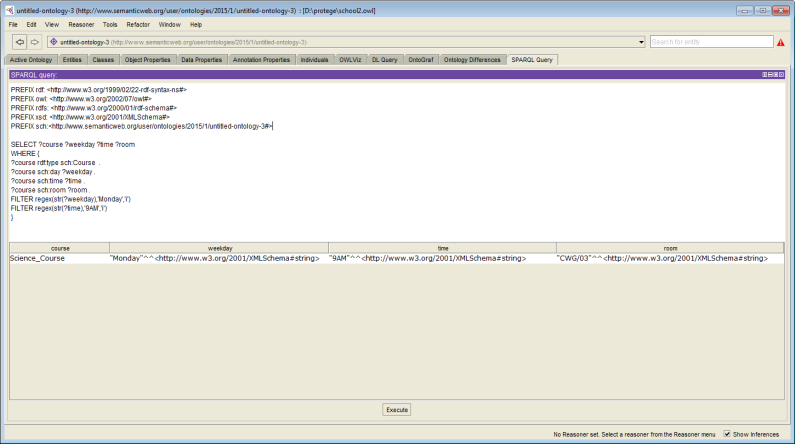
Science course is taught Monday at 9AM in room CWG/03.
- How many girls take science in year 10?
PREFIX rdf: <http://www.w3.org/1999/02/22-rdf-syntax-ns#>
PREFIX owl: <http://www.w3.org/2002/07/owl#>
PREFIX rdfs: <http://www.w3.org/2000/01/rdf-schema#>
PREFIX xsd: <http://www.w3.org/2001/XMLSchema#>
PREFIX sch:<http://www.semanticweb.org/user/ontologies/2015/1/untitled-ontology-3#>
SELECT (MAX(?course) as ?course_name) (COUNT(?students) AS ?no_students)
WHERE {
?course rdf:type sch:Course .
FILTER regex(str(?course),’Science_’,’i’) .
?course sch:hascourse ?students .
?students a ?type .
FILTER( regex(STR(?type), ‘Year10’)) .
?students sch:gender ?gender .
FILTER regex(str(?gender),’F’,’i’) .
}
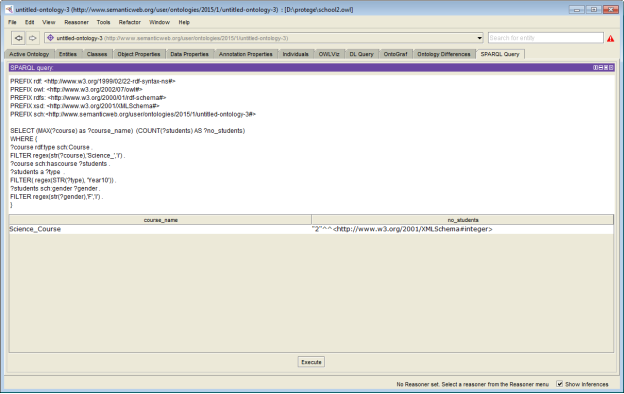
The number of girls who take science in year 10 is 2.
- How old is the head teacher?
PREFIX rdf: <http://www.w3.org/1999/02/22-rdf-syntax-ns#>
PREFIX owl: <http://www.w3.org/2002/07/owl#>
PREFIX rdfs: <http://www.w3.org/2000/01/rdf-schema#>
PREFIX xsd: <http://www.w3.org/2001/XMLSchema#>
PREFIX sch:<http://www.semanticweb.org/user/ontologies/2015/1/untitled-ontology-3#>
SELECT ?task ?num
WHERE {
?task rdf:type sch:Headteacher .
OPTIONAL {?task sch:age ?num }
}
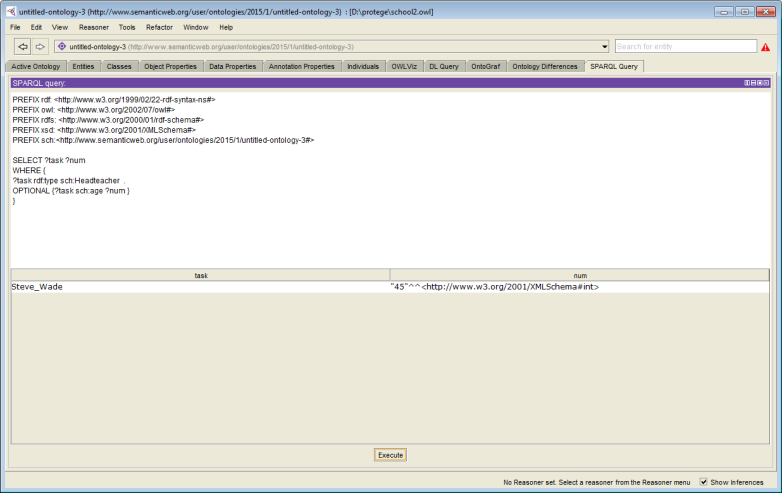
The headteacher is 45 years old.
- What teacher is head of the sports department?
PREFIX rdf: <http://www.w3.org/1999/02/22-rdf-syntax-ns#>
PREFIX owl: <http://www.w3.org/2002/07/owl#>
PREFIX rdfs: <http://www.w3.org/2000/01/rdf-schema#>
PREFIX xsd: <http://www.w3.org/2001/XMLSchema#>
PREFIX sch:<http://www.semanticweb.org/user/ontologies/2015/1/untitled-ontology-3#>
SELECT ?name
WHERE {
?name rdf:type sch:Sports_head .
 }
}
His name is Martin Richards
- Who teachers Geography and also Sports?
PREFIX rdf: <http://www.w3.org/1999/02/22-rdf-syntax-ns#>
PREFIX owl: <http://www.w3.org/2002/07/owl#>
PREFIX rdfs: <http://www.w3.org/2000/01/rdf-schema#>
PREFIX xsd: <http://www.w3.org/2001/XMLSchema#>
PREFIX sch:<http://www.semanticweb.org/user/ontologies/2015/1/untitled-ontology-3#>
SELECT ?teacher ?teaches
WHERE {
?teacher rdf:type sch:Teachers .
?teacher sch:IsLecturerOf ?teaches .
FILTER (regex(str(?teaches),’Geography_’,’i’) || regex(str(?teaches),’Sports’,’i’)) .
}
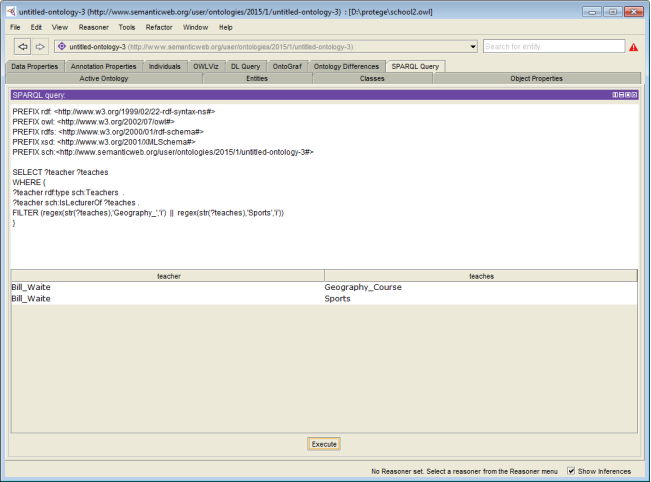
Bill Waite teaches both Geography and Sports.
- Please give all the names of teachers and their email addresses if known. (Optional patterns, week 6, lecture 5, slide 12)
PREFIX rdf: <http://www.w3.org/1999/02/22-rdf-syntax-ns#>
PREFIX owl: <http://www.w3.org/2002/07/owl#>
PREFIX rdfs: <http://www.w3.org/2000/01/rdf-schema#>
PREFIX xsd: <http://www.w3.org/2001/XMLSchema#>
PREFIX sch:<http://www.semanticweb.org/user/ontologies/2015/1/untitled-ontology-3#>
SELECT ?name ?email
WHERE {
?name rdf:type sch:Teachers .
OPTIONAL {?name sch:email ?email } .
}
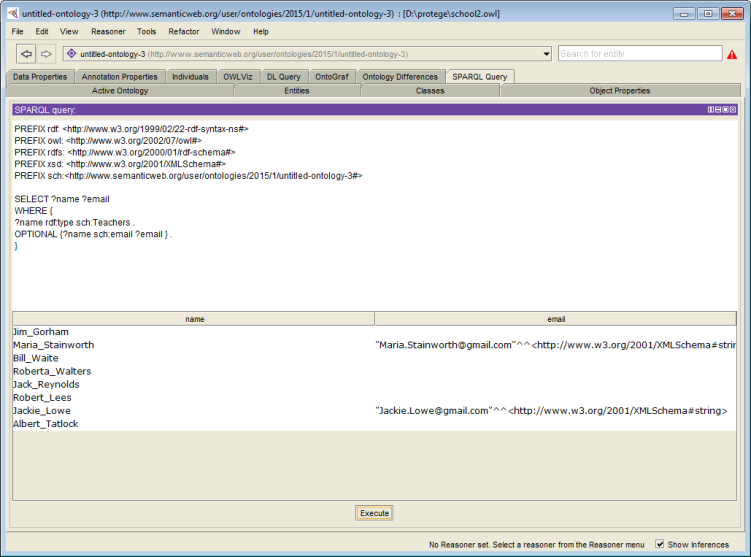
- How many of the admin team are under 40 years of age?
PREFIX rdf: <http://www.w3.org/1999/02/22-rdf-syntax-ns#>
PREFIX owl: <http://www.w3.org/2002/07/owl#>
PREFIX rdfs: <http://www.w3.org/2000/01/rdf-schema#>
PREFIX xsd: <http://www.w3.org/2001/XMLSchema#>
PREFIX sch:<http://www.semanticweb.org/user/ontologies/2015/1/untitled-ontology-3#>
SELECT (COUNT(?all) AS ?total)
WHERE {
{ ?all rdf:type sch:Receptionist }
UNION { ?all rdf:type sch:Secretary }
UNION { ?all rdf:type sch:Switchboard_Operator } .
?all sch:age ?yrs .
FILTER (?yrs < 40)
}
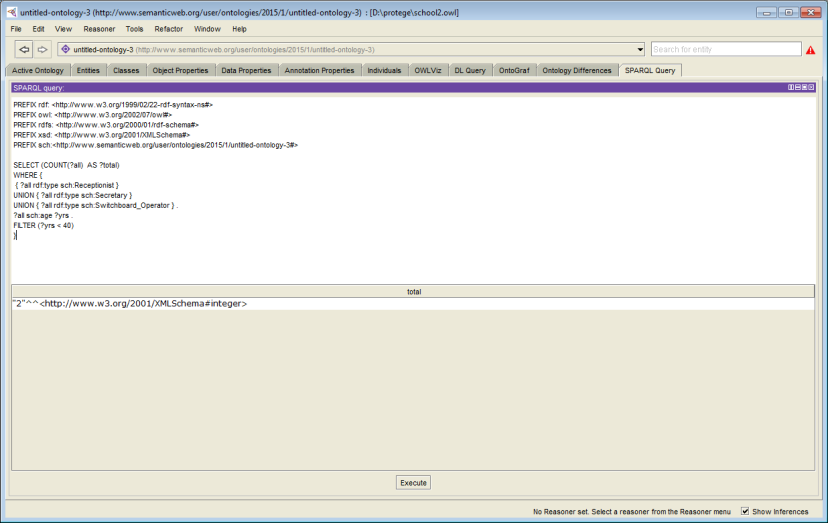
There are 2 members of the admin team that have less than 40 years.
- What members of the admin staff surname begins with “W”
PREFIX rdf: <http://www.w3.org/1999/02/22-rdf-syntax-ns#>
PREFIX owl: <http://www.w3.org/2002/07/owl#>
PREFIX rdfs: <http://www.w3.org/2000/01/rdf-schema#>
PREFIX xsd: <http://www.w3.org/2001/XMLSchema#>
PREFIX sch:<http://www.semanticweb.org/user/ontologies/2015/1/untitled-ontology-3#>
SELECT  ?all
WHERE {
{ ?all rdf:type sch:Receptionist }
UNION { ?all rdf:type sch:Secretary }
UNION { ?all rdf:type sch:Switchboard_Operator } .
FILTER regex(str(?all),’_w’,’i’)
}
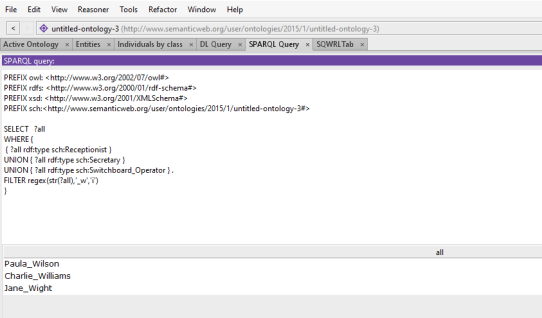
Paula Wilson, Charlie Williams and Jane Wight are the admin members whose surname begins with ” W”.
- Retrieve all teachers and their qualifications
PREFIX rdf: <http://www.w3.org/1999/02/22-rdf-syntax-ns#>
PREFIX owl: <http://www.w3.org/2002/07/owl#>
PREFIX rdfs: <http://www.w3.org/2000/01/rdf-schema#>
PREFIX xsd: <http://www.w3.org/2001/XMLSchema#>
PREFIX sch:<http://www.semanticweb.org/user/ontologies/2015/1/untitled-ontology-3#>
SELECT ?teacher ?teaches
WHERE {
?teacher rdf:type sch:Teachers .
?teacher sch:IsLecturerOf ?teaches .
}
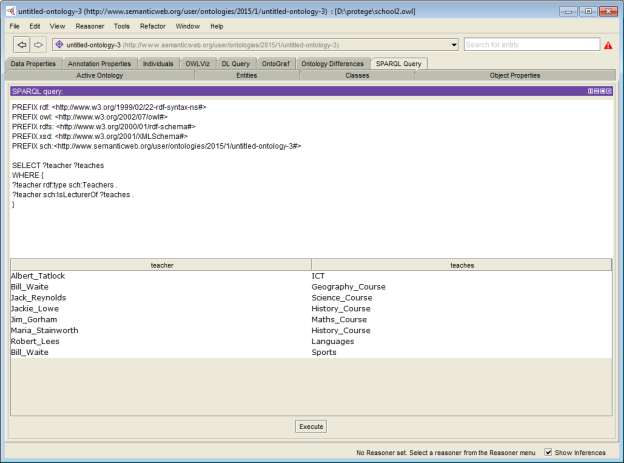
- Retrieve the name of all subjects taught by the teacher with ID 2341
PREFIX rdf: <http://www.w3.org/1999/02/22-rdf-syntax-ns#>
PREFIX owl: <http://www.w3.org/2002/07/owl#>
PREFIX rdfs: <http://www.w3.org/2000/01/rdf-schema#>
PREFIX xsd: <http://www.w3.org/2001/XMLSchema#>
PREFIX sch:<http://www.semanticweb.org/user/ontologies/2015/1/untitled-ontology-3#>
SELECT ?teacher ?id ?subjects
WHERE {
?teacher rdf:type sch:Teachers .
?teacher sch:ID ?id
FILTER (?id=2341)  .
?teacher sch:IsLecturerOf ?subjects
}
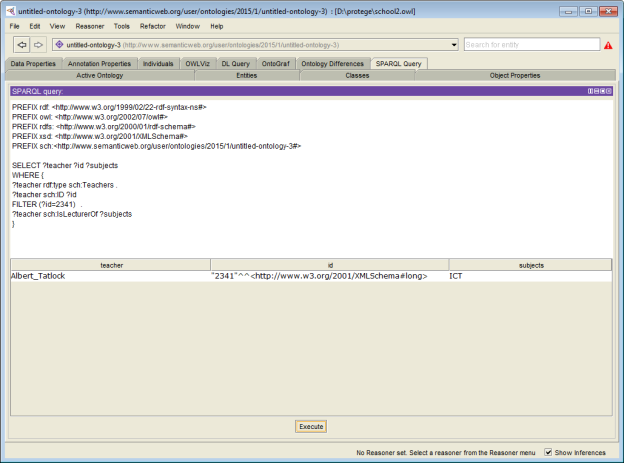
Albert Tatlock, the teacher with ID 2341, teaches ICT.
- DBPedia
A timetable query.

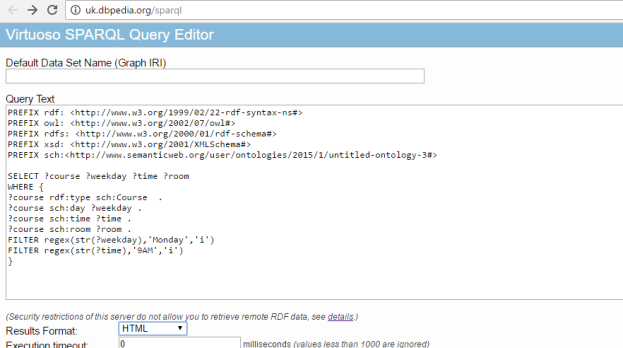
Results in HTML
- Ontology-Oriented Inference-Based Learning Content Management System Application
Semantic web technologies based upon ontology are considered as the promising solution in order to provide an explicit definition of the shared conceptualisation regarding certain domain as well as acknowledging assemblage of e-learning contents. Ontologies integrated with profiles of the learner integrate to provide enhanced results within an e-learning LMS system. It could be used in contrast with multi-agent technologies in order to derive personalised learning paths (Stevenson, 2015). The domain of courses can be easily managed by ontology and provide explicit details of education establishment as well as adaptation of students’ learning paths.
General Concepts of LCMS
LMS is regarded as the software package, usually applied on the large scale that enables the delivery of learning resources and courses and management to students. Most of the LMS systems are web-based in order to facilitate anywhere, anytime access to administration and learning content. LMS is referred to as the reporting systems and do not include ways to develop new content or to deliver small learning packets (Icoza, 2015). LMS is fashioned for tracking test results, registration, class lists, grades, managing all learning events within the academics institute and class scheduling.
In contrast, the LCMs focus upon the learning content. It provides authors, subject matter experts, and instructional designers to means to develop e-learning content in a more effective way. The core concern that is resolved by LCMs is to develop sufficient content just in time to meet the requirements of the learners’ group or individual learners (Kuhn, 2012). Instructional designers develop chunks of reusable content rather than entire courses and acclimatising to multiple audiences, and make them available to the course developers all through the academic institute.
Sequence Diagram
The sequence of steps is performed on the retrieve and query as mentioned in the figure below. The flow proceeds as follows:
- The user search for certain information after the registration to system
- Then, the semantic-based LMS check the validation of the query
- The system informs him about, if there is any error in request sending or if the query is invalid
- If the query is valid, then the system gets the query at repository data as well as user history repository, and sees there is any existing data (Kuhn, 2012).
- The system notifies him about the existence of data, if the data exists, then data is retrieved by the system makes an inference to that of fetching data by deploying the rules of validation
- It saves the result of inference to the repository and includes the outcomes to the original retrieved data and responses to the operator.

Figure: Sequence Diagram
- Fundamental Ontologies
The system is based on the ontological framework to allow formal demonstration of learning content along with its principle building blocks such as; different types of learning activities, learning content, participants within the process of learning i.e. teaching assistants, teachers, learners, etc. (Ferraram, 2013). The ontology domains defined can be salvaged by other ontologies, therefore assimilating various contemporary technologies under single ontology illustrating a large domain.
Describing Classes
Three primary classes will be defined i.e. users, institutions, and learning resources. The institution class is further divided into colleges. The learning resource class incorporates a list of overall courses as its user class and subclasses consists of a list of every type of users i.e. instructor, student, and administrator (Jain, 2013). The overall classes are sub classed under one class <owl:Thing> that exemplifies overall classes root.
Outlining Properties
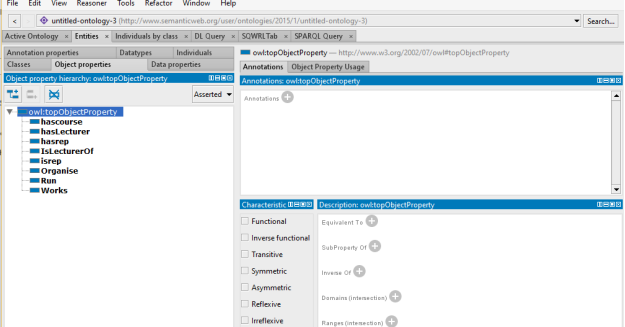
Figure: Object Properties

Figure: Datatype Properties
The ontology of the learning resources is the core of this framework has been demonstrated in the graph illustrated below using the OntoGraft (Kholief, 2012). It consists of a number of properties and classes aimed at formally signifying learning content. The ontologies have been divided into two segments; information of learning course and learning content information. The class courses is the one that has been opted by more than one learner while interrelating with customers.
The other class consists of the course content such as; lab experience, PowerPoint lectures, notes, and media. Moreover, the courses are also divided into the subclasses. Class course specifications incorporate the information regarding the field, term, and the course type. In addition, class course enrolment includes information regarding the enrolment of students on certain course (Icoza, 2015). The ontology signifies characteristics to the overall procures of E-learning i.e. Preferences and basic personal data along with the speciation of the features of leaner-specific, including multiple dimensions of learning styles and performance.
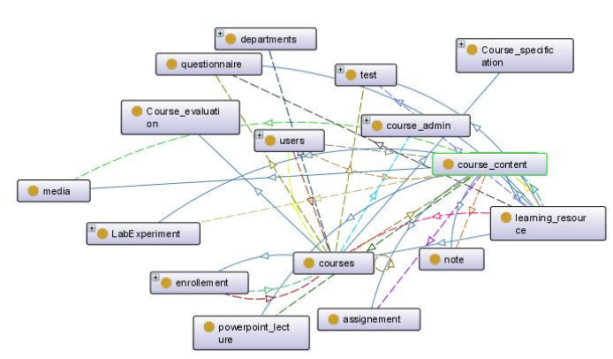
Figure: Projected Learning Resource Ontology
- Class Diagram
A class diagram is the UML structure diagram that illustrates the structure of designed system by exemplifying the classes in the system, constraints, relationships, their features, amongst the classes.  Moreover, the active entities of the anticipated systems include; courses, students, course administrator, and course content. The entities of the business domain include; test, enrolment, course evaluation, and course specification (Kuhn, 2012). The class diagram of the projected system has been illustrated in the below mentioned figure.
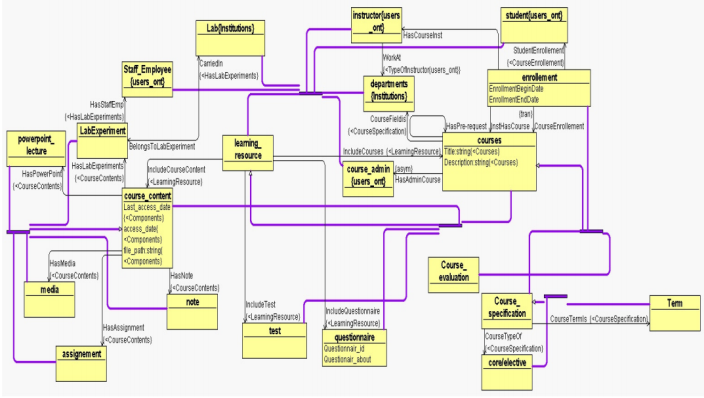
Figure: Class diagram of Learning Resources ontology
- Logical Rules

The above mentioned rules demonstrate the semantic probing of course content upon the system. The explanation of the rules is mentioned below.
- rules 1; the privilege of the learner to course content ie enrollment
- rules 2; pre-request courses of various courses (Ferraram, 2013).
- rule 3; topic of certain contents such as; authentication lectures of course database is linked to security of topic too
Related Work
The research will incorporate the approaches of e-learning content management along with the semantic approach that is associated with the represented work. The review has enhanced the e-learning environments with that of the semantic-rich cognisance information. It has intended the educators to utilise this information when updating learning content for future courses. Therefore, heuristics have been developed that allow both; the convergence of LCMS log data and the intelligent analysis into the ontologies of the Semantic web. ILMSs (Intelligent LMSs) have linked the modern approach to the web-based education is dependent upon the LMSs, but under adaptive hypermedia and intelligent tutoring technologies (Kholief, 2012). As the generation of the new Web, the Semantic web has improved conditions for reusing and composing the learning materials.
The research has been aimed to develop a simple, learner-oriented, and customised e-learning system as well as to create the material of particular course conforming SCORM. The research emphases upon the development of an ontology of student model that is appropriate with the needs of learning procedures in the faculty of computer science. The oncology has, moreover, incorporated the knowledge regarding student learning styles, student data, as well as the performance of the students (Jain, 2013). The research is based upon the approach, identifying such of those learning objects that amalgamate information technology and educational pedagogy via instructional design.
- Brief Phenomenon of Ontologies
The term Ontology comes from the world of philosophy is the part of metaphysics that deals with being in general and of their transcendental properties, or properties that transcend the limits of the merely experimental (Wanner et al, 2015). This concept has been adopted by computer science, specifically in the domain of artificial intelligence, adapting it to their needs, and using a metaphor according to which the experimental, physical, tangible, objective and recordable would be the data, and the metaphysical, inedible, subjective would be informative. More rigorously, this metaphorical adoption has given rise to a wide variety of definitions of this new concept, a product of the points of view of diverse authors and, fundamentally, of the different ways of constructing and using ontologies as computer systems (Brizzi et al, 2016). Among the most well-known and used definitions is that states that that an ontology constitutes an explicit and formal specification of mental abstractions, which are shaped by an agreement of the expert community in a domain and in a design for a specific purpose this definition implies a multitude of aspects that contribute to clarify this concept.
Therefore, when analysed in detail, it is ontology provides the structure for a vocabulary controlled in a way similar to a dictionary or a thesaurus. This vocabulary, agreed by the community, is expressed through concepts, thus conforming the abstractions (Johnson, 2016). On the other hand, in terms of the formal specification of a vocabulary, this could be in various forms, such as a flat list of words, a dictionary, a taxonomy, an entity-relationship diagram, a Unified Mark-up Language (UML) model, an XML schema and many other possible ones (Goodchild, 2013). However, the ontologies are much more than described so far and to give a small sample that its possibilities are not confined and trying to clarify and deepen especially, it has resorted to the definition of Neches and employees.
It has been argued that ontology defines the vocabulary of an area through a set of basic terms and relations between these terms, as well as such, as rules that combine terms and relationships that extend given definitions in the vocabulary (Kuhn, 2012). This assumes that the ontologies are not formed only by mere concepts with a certain organisation, which would not be much more distant of a thesaurus, but also relations, rules, and axioms are given between concepts that enrich and contribute to expanding the vocabulary of the work domain. In order to clarify, with a concrete case, what is ontology is included below an example regarding possible travel ontology (Stocker et al, 2014). Within it would be all the relevant concepts related to the subject in question, among others: travel, flight, the client, lodging, road, departure, arrival, rate, etc.
In this ontology, everything would start from the key concept, trip. Of the same, the different types of trips that a person can perform (flight, train, bus, by boat, etc.). Also, it is the fact that every trip has a single date, time and place of departure and a single date, time and place of arrival, a company and a tariff, concepts all that would be part of the ontology (Whitehead et al, 2013). Once all the basic concepts have been defined, the relations between them, for example, a trip of a certain type with a place of departure and another one of arrival corresponds a determined duration. Another possible relationship would be formed by the place of the concept of departure, place of arrival, and itinerary by road, and that a certain sequence of roads connects two different places.
The complexity and variety of relationships can become as can imagine since the multiplicity of relationships can achieve a system much more powerful and effective. Thus, a city of origin may have as points of departure a particular bus station, a train station or an airport (Jain, 2013). Different points of departure that will be depending on the chosen destination or on other issues such as schedules or economic ailments, among others. With this complexity of criteria, intelligence implemented in the system this will be able to guide to the most suitable station or airport, at a certain time and with the relevant transhipments. In this way, the efficiency can be management process of any trip, greatly facilitating the whole process (Ferraram, 2013). Another important element that is part of the ontologies are the axioms (logical expressions), which serve to define meaningful constraints of the type such as, “is not possible to travel from the USA to Europe by train “or” it is not possible to travel by boat between Madrid and Barcelona”.
In addition to it, this small ontology could be implemented on an Information System (GIS), helping to manage all this information in a more efficient and autonomous, because it will allow the user to know what type of transport takes you from one city to another, days and times of departure and arrival, fares, durations, accommodation, etc., all in a smart and automated way. Without forgetting that the information to be obtained can be as much or more complex as it goes bringing greater complexity and richness to the ontology (Maedche, 2012). The variety existing in the definitions is transferred to the typologies; it is for this reason, and so the individual can find a wide range of them.
Among the most extended is the classification, it can be understood that there are two major types of ontologies; The dependents of the domain and dependent on the task, both in turn subdivided into other types. The first provides a systematised vocabulary which is intended to describe the terms employed in a given domain, for example, on medical pathology ontologies, the management or hydrographic phenomena will appear concepts of the type surgery, investment fund or river respectively (Shvaiko, 2013). On the other hand, the dependents of the vocabulary systematised with the terms used in solving the problems associated with a series of tasks that may or may not be the same domain, but that has some similarity between them: ontologies of responsibilities, of security, or project management. In this type of ontologies the concepts that are not mere descriptions of the domain, but actions aimed at solving a certain problem, therefore, the concepts of the type objective, “resolution,” “action.” From these definitions, several conclusions can be drawn: on the one hand, in the ontologies knowledge is specified through concepts.
That is, it is formed by a grouping of concepts that result in the way of seeing the world, common and shared, according to a certain perspective before a domain of knowledge (Li, 2015). On the other hand, the fact that between the concepts there are relations, rules of inference, axioms, etc. Which contribute to the enriching knowledge of the domain in question. It should be noted that these formalised conceptualisations allow the communication between experts and computer systems, a direct consequence of the information is not only understandable by people, as it was so far, however, is also understood by the machines, which will affect a constant reuse of knowledge. Therefore, the construction of ontologies will give rise to a significant improvement in the representation of the GI, with a direct impact on the recovery systems, consultation, and analysis of information (Wanner et al, 2015). As a summary, when referring to the Semantic Web, point to ontologies as a useful instrument, insofar as they define the relations between terms, for which fundamentally with a taxonomy and with a set of rules of inference.

References
Brizzi, P., Bonino, D., Musetti, A., Krylovskiy, A., Patti, E., &Axling, M. (2016, July). Towards an ontology driven approach for systems interoperability and energy management in the smart city. In Computer and Energy Science (SpliTech), International Multidisciplinary Conference on (pp. 1-7). University of Split, FESB. Retrieved from
Carral, D., Scheider, S., Janowicz, K., Vardeman, C., Krisnadhi, A. A., &Hitzler, P. (2013, May). An ontology design pattern for cartographic map scaling. In Extended Semantic Web Conference (pp. 76-93). Springer Berlin Heidelberg. Retrieved from
Ferraram, A., Nikolov, A., &Scharffe, F. (2013). Data linking for the semantic web. Semantic Web: Ontology and Knowledge Base Enabled Tools, Services, and Applications, 169. Retrieved from
Goodchild, M. F. (2013). Prospects for a space-time GIS: Space-time integration in geography and GIScience. Annals of the Association of American Geographers, 103(5), 1072-1077. Retrieved from
Icoza, K., Ozdemird, E.B., Sanalanb, V.A., Cakarc, M.A. and Kayae, S., 2015. Using Students’ Performance to Improve Ontologies for Intelligent E-Learning System. Educational Sciences: Theory & Practice, 4, pp.1-12. Retrieved from https://www.researchgate.net/profile/Mehmet_Cakar2/publication/280918523_Using_Students’_Performance_to_Improve_Ontologies_for_Intelligent_E-Learning_System/links/55caf9dc08aeca747d69fabc.pdf
Jain, V., & Singh, M. (2013). Ontology based information retrieval in semantic web: A survey. International Journal of Information Technology and Computer Science (IJITCS), 5(10), 62. Retrieved from
Johnson, L. E. (2016). Geographic information systems in water resources engineering. CRC Press. Retrieved from
Kholief, M., Nada, N. and Khedr, W., 2012. Ontologyoriented inference-based learning content management system. International Journal of Web & Semantic Technology (IJWesT), 3(3), pp.131-142. Retrieved from
Kuhn, W. (2012). Core concepts of spatial information for transdisciplinary research. International Journal of Geographical Information Science, 26(12), 2267-2276. Retrieved from
Li, S., &Mackaness, W. A. (2015). A multi-agent-based, semantic-driven system for decision support in epidemic management. Health informatics journal, 21(3), 195-208. Retrieved from
Maedche, A. (2012). Ontology learning for the semantic web (Vol. 665). Springer Science & Business Media. Retrieved from
Shvaiko, P., &Euzenat, J. (2013). Ontology matching: state of the art and future challenges. IEEE Transactions on knowledge and data engineering, 25(1), 158-176. Retrieved from
Stevenson, G., 2015. An approach to situation recognition based on learned semantic models (Doctoral dissertation, University of St Andrews). Retrieved from
Stocker, M., Baranizadeh, E., Portin, H., Komppula, M., Rönkkö, M., Hamed, A., …&Kolehmainen, M. (2014). Representing situational knowledge acquired from sensor data for atmospheric phenomena. Environmental Modelling & Software, 58, 27-47. Retrieved from
Tolk, A. (2013). Ontology, epistemology, and teleology for modeling and simulation. Berlin. Retrieved from
Wanner, L., Rospocher, M., Vrochidis, S., Johansson, L., Bouayad-Agha, N., Casamayor, G., …&Serafini, L. (2015). Ontology-centered environmental information delivery for personalized decision support. Expert Systems with Applications, 42(12), 5032-5046. Retrieved from
Whitehead, B., Adams, B., Schildhauer, M., Vardeman, C., Kuhn, W., Shepherd, A., & Sinha, K. (2013, October). Abstracting transport to an ontology design pattern for the geosciences. In Proceedings of the 4th International Conference on Ontology and Semantic Web Patterns-Volume 1188 (pp. 88-92). CEUR-WS. org. Retrieved from